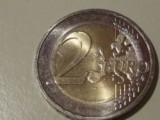Counterfeit Euro coins
The practice of coin counterfeiting goes almost as far back in human history as coinage itself. When Eurozone governments began to exchange Euro coins for the coins of previous national currencies in 2002, however, they were confident that they had one of the most difficult coinages in the world to counterfeit.
The most notable anti-counterfeiting measure in the Euro coinage is the bimetallic construction of the highest-value coins. The one- and two-Euro coins are composed of two different alloys. Bimetallic coins are difficult for counterfeiters to replicate effectively because of the costs involved in minting them.
Initially, counterfeiting levels in the Eurozone were low. Police captured a total of around 26,000 counterfeit Euro coins in 2003. The relative novelty of the currency also helped to keep counterfeit totals down. However, as time went on and new countries were added to the Eurozone, the number of counterfeit Euro coins steadily increased. Over 150,000 were seized from circulation in 2011, and this is believed to be only a small fraction of the total. Nonetheless, the total number of counterfeit Euro coins remains small compared to many other currencies.
Large-scale counterfeiting operations may require specialised equipment, but this is not impossible for organised crime groups. In June 2012, two counterfeiters were arrested in northern Greece with equipment and parts to manufacture over 100,000 Euros worth of counterfeit two-Euro coins. Another counterfeiting ring was uncovered in Germany in 2011. Germany’s Bundesbank will exchange Euro coins being removed from circulation for new ones. The old coins are sold to China as scrap metal after being broken into two parts; a counterfeiting ring was reassembling the components and smuggling them back into Germany. These coins, being actual Euro coins, were difficult to detect.
Like all counterfeit coins, counterfeit Euro coins are likely to have defective features, including unclear lettering or soft detail in the design. Errors in the milling or scalloping of the edges are also common, as are rapid wear on the soft metal.
Although it is not technically counterfeiting, use of foreign coins as Euro coins has also been a problem within the Eurozone, particularly for vending machines. As other countries imitate the Euro’s coin designs, similar coins can appear so similar to Euros that they pass unsuspecting merchants or fool the sensors in vending machines. The Turkish one-lira and 50-kurus coins, introduced in 2005, superficially resemble the one- and two-Euro coins; these coins can occasionally be found in circulation in the Eurozone. Since a Turkish lira is worth around 50 cents, this caused a problem for vending machine manufacturers. Modern Euro vending machines can now distinguish between the coins.
Because counterfeit Euro coins are rare compared to authentic coins. Other currencies show a much higher rate of counterfeited coins. For instance, a 2008 study estimated the number of counterfeit pound coins in circulation at 37.5 million, or nearly twenty times the estimated number of counterfeit Euro coins — a higher number of fakes in a much smaller currency. As a result, tourists are unlikely to encounter fake Euro coins.
Using or spending counterfeit currency is a criminal offence. If you are unfortunate enough to be passed counterfeit euro coins (or any other currency) then the advice is that you take it to a local Police station.
Send your coins to us now




















